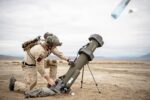U.S.-based Fairbanks Morse Defense (FMD) has acquired Norwegian firm Vestdavit AS in a strategic move aimed at expanding its capabilities in naval launch and recovery systems. The acquisition strengthens FMD’s position as a full-spectrum provider of mission-critical shipboard equipment for the U.S. Navy and allied fleets.
Strategic Fit: Expanding Beyond Propulsion into Deck Handling
Fairbanks Morse Defense is widely recognized for its marine propulsion systems—particularly diesel engines powering U.S. Navy surface ships and submarines. However, over the past three years, FMD has aggressively diversified its portfolio through acquisitions targeting shipboard support systems. The acquisition of Bergen-based Vestdavit represents a significant step into topside handling equipment—specifically davit systems used for launching and recovering small boats in challenging sea states.
Vestdavit specializes in high-performance davits designed for naval applications requiring rapid deployment of RHIBs (rigid-hulled inflatable boats), unmanned surface vessels (USVs), and other mission-critical payloads. Its solutions are widely used by NATO navies including Norway, the UK Royal Navy, Germany’s Bundeswehr, and others.
This acquisition complements FMD’s existing offerings such as propulsion controls, monitoring systems, and aftermarket services. It also aligns with the company’s strategy to provide integrated maritime solutions across propulsion, power generation, deck machinery, MRO (maintenance repair & overhaul), and now launch/recovery operations.
Vestdavit’s Niche Capabilities in Harsh Maritime Environments
Founded in 1975, Vestdavit has built a reputation for supplying robust davit systems capable of operating in Sea State 6 conditions—a critical requirement for navies operating globally under demanding conditions. Its product line includes single-point davits (SLD), dual-point A-frame davits (PLD), telescopic units (TSD), and containerized modular launch/recovery platforms.
Key technical features include:
- Shock-absorbing winches with dynamic load control
- Anti-pendulation technology for safe boat handling
- Remote control integration with ship C2/bridge interfaces
- CERT/IMO/SOLAS compliance across configurations
The company has also been active in supporting unmanned system deployment needs—an area of growing interest as navies expand their use of USVs for ISR (intelligence/surveillance/reconnaissance), mine countermeasures (MCM), and ASW (anti-submarine warfare) missions.
A Broader Acquisition Strategy Targeting Lifecycle Support
The purchase of Vestdavit is part of a broader pattern by Fairbanks Morse Defense to acquire niche OEMs that support lifecycle sustainment models favored by Western navies. Since becoming part of Arcline Investment Management’s defense portfolio in 2020, FMD has acquired several companies including:
- Ward Leonard: Electrical control systems for naval platforms
- Delfin Group: Maritime HVAC/R solutions
- BraunAbility Marine Division: Specialized access equipment adapted to military standards
This ecosystem approach allows FMD to offer bundled sustainment packages under IDIQ contracts or foreign military sales (FMS) frameworks—particularly useful amid tightening defense budgets where total cost of ownership is scrutinized.
Implications for U.S. Navy Shipbuilding Programs
The integration of Vestdavit’s technology could have direct implications on several ongoing or planned U.S. Navy programs that require advanced small craft handling capabilities:
- Littoral Combat Ship (LCS): Modular mission packages involving RHIBs/USVs benefit from rapid launch/recovery gear.
- Constellation-class Frigates: Designed with multi-mission flexibility; modular davit options may be considered during outfitting phases.
- Navy Expeditionary Fast Transport (EPF): High-speed logistics vessels increasingly deploy unmanned or manned small craft.
The acquisition may also position FMD-Vestdavit solutions favorably within NATO standardization efforts under STANAG guidelines related to interoperability of boat handling equipment across allied fleets.
NATO Market Access and Global Expansion Potential
Vestdavit brings not only technical expertise but also market access across European NATO members where it maintains long-standing relationships with procurement agencies and integrators such as Damen Naval (Netherlands) or BAE Systems Maritime Services UK. This footprint could help Fairbanks Morse Defense expand beyond its traditional U.S.-centric client base into European modernization programs including:
- Norwegian Coast Guard P6615 series vessels built by VARD Langsten
- British Type 31 frigates under Arrowhead program using modular topside architecture
- Dutch Combat Support Ship Den Helder class outfitting phase requirements
This cross-market synergy aligns with transatlantic defense industrial cooperation goals emphasized by NATO’s DIANA initiative and EU PESCO programs focused on maritime resilience technologies.
MRO Synergies & Aftermarket Sustainment Model Integration
A key rationale behind the deal is integrating Vestdavit’s installed base (~2000+ units globally) into FMD’s growing aftermarket services infrastructure. With over a dozen service hubs across North America already supporting engine maintenance contracts with the U.S. Navy via NAVSEA/NAVSUP frameworks, FMD can now offer integrated maintenance plans covering propulsion plus deck handling gear—streamlining logistics footprints aboard deployed vessels.
This is especially relevant as navies seek readiness-focused sustainment models emphasizing predictive maintenance via digital twins or condition-based monitoring—a capability both firms have signaled intent to develop further post-merger.
Conclusion: A Tactical Acquisition with Strategic Reach
The Fairbanks Morse–Vestdavit deal reflects a maturing trend among maritime defense OEMs seeking vertical integration across platform subsystems—from powerplants to topside mission modules. By acquiring a proven player in naval boat-handling technology with strong NATO credentials and harsh-weather performance pedigree, FMD positions itself as an end-to-end supplier capable of supporting next-generation fleet architectures centered on modularity, unmanned integration, and lifecycle cost efficiency.








